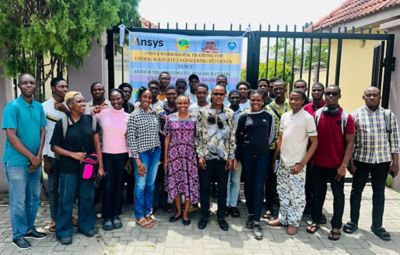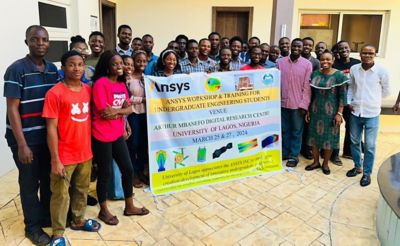-
United States -
United Kingdom -
India -
France -
Deutschland -
Italia -
日本 -
대한민국 -
中国 -
台灣
-
Ansys s'engage à préparer les étudiants d'aujourd'hui à la réussite, en leur fournissant gratuitement un logiciel de simulation.
-
Ansys s'engage à préparer les étudiants d'aujourd'hui à la réussite, en leur fournissant gratuitement un logiciel de simulation.
-
Ansys s'engage à préparer les étudiants d'aujourd'hui à la réussite, en leur fournissant gratuitement un logiciel de simulation.
-
Contactez-nous -
Carrières -
Étudiants et universitaires -
-
S'inscrire -
Déconnexion -
Espace client -
Support -
Communautés partenaires -
Contacter le service commercial
Pour les États-Unis et le Canada
+1 844.462.6797
-

Reinforcing its commitment to supporting the next generation of engineers, Ansys announced that it would contribute $250,000 toward funded curriculum proposals. Through two successful open calls supported by the Ansys Academic Program, Ansys invited educators of accredited academic institutions from around the world to submit proposals to reshape existing undergraduate engineering curricula or develop new curricula using Ansys’ simulation tools in strategic ways. The first open call gave priority to proposals that spanned multiple courses in a department and included simulation in at least one first- or second-year course while the second focused on undergraduate engineering courses covering sustainability or electronics topics.

University of Lagos (UNILAG) senior lecturers Olabode Thomas Olakoyejo, Ph.D. (far left), and Olayinka Adewumi, Ph.D. (center left), with former graduate student Ibrahim Fetuga (center right), welcomed undergraduate engineering students to an Ansys workshop and training session in March.
As a recipient of the first open call, the University of Lagos (UNILAG) in Nigeria was awarded a grant to support the integration of Ansys simulation into engineering courses centered around computational fluid dynamics (CFD). Thanks to the funding, about 1,000 students across three undergraduate engineering courses gained hands-on simulation experience during the 2023-2024 academic school year. The courses will continue to provide value as new students enter the program each year.
Delivering In-demand Simulation Skills
The proposal was initiated by a five-member team from UNILAG’s Department of Mechanical Engineering, including senior lecturers Olabode Thomas Olakoyejo, Ph.D., and Olayinka Omowunmi Adewumi, Ph.D.; associate professor Adekunle Adelaja, Ph.D.; and former graduate students Ibrahim Fetuga and Samuel Omosehin.

Adewumi (left) introduces students to research being conducted by Fetuga, who led an Ansys training session (right).
“All team members have used Ansys Fluent software for Ph.D., postdoctoral, and master’s research work, and we were convinced the Ansys Workbench platform is a package that can give our students the hands-on practical design, simulation, and analysis skills they need as aspiring engineers,” says Olakoyejo. “The application for the grant was necessitated by the changing approach to solving problems in fluid flow and heat transfer engineering. While analytical and numerical approaches are still necessary, the use of Ansys simulation software is gaining ground as a veritable tool for solving problems with the possibilities of visualization and animation.”
Fluent fluid simulation software is used to model fluid flow, heat and mass transfer, chemical reactions, and more, offering a user-friendly interface that streamlines the CFD process from pre- to post-processing in a single-window workflow. Fluent software is known for its advanced physics modeling capabilities for turbulence, single and multiphase flows, combustion, batteries, fluid-structure interaction, and other fluid dynamics.
The Workbench simulation integration platform easily connects Ansys products from within one space. The project schematic enables users to configure their simulation processes, optimize exploration through parametric management, submit jobs to solvers both locally and remotely, and add application programming interfaces (APIs) that allow for third-party software.
With the awarded funding, UNILAG integrated the software into three courses: Fundamentals of Fluid Mechanics, Fundamentals of Thermodynamics, and Introduction to Heat and Mass Transfer.
In connection, program leaders held workshops and training sessions for the students, featuring incentives like a competition with cash prizes.
“We used the funding to develop tutorial materials to teach the students during virtual sessions, data collation, and feedback analysis,” says Olakoyejo.
Olakoyejo and the team selected the courses for their significance in the mechanical engineering program, as well as their importance across other disciplines and departments. For example, Fundamentals of Fluid Mechanics is a facultywide course for second-year engineering students, but it’s also available to students in other departments, including electrical and electronics, computer, metallurgical and material, and biomedical and system engineering. Due to its multidisciplinary applications, the course is fundamental for engineering students and serves as a prerequisite for other courses related to heat transfer, refrigeration and air conditioning, and power plant engineering.

UNILAG associate professor Adekunle Adelaja, Ph.D., showcases some of his research using Ansys computational fluid dynamics (CFD) simulation, including biomedical modeling.
Fundamentals of Thermodynamics similarly welcomes second-year undergraduate students inside and outside the mechanical program, including students from the civil, systems, biomedical, and metallurgical and materials engineering departments, as well as the building and technology education department.
In contrast, Introduction to Heat and Mass Transfer is designed specifically for mechanical engineering undergraduate students in their fourth year. However, it still has an impactful reach. The course focuses on heat and mass transfer — two of fluid mechanics’ most popular processes, which are used in a wide range of applications and industries, including domestic appliances, power generation and nuclear plants, pharmaceuticals, process and manufacturing, refrigeration and air conditioning, indoor air quality, and petroleum and gas.
Putting CFD Into Practice
“Teaching with Ansys Fluent software will give the students mastery in CFD tools, which will make them competitive for the local and international job market, postgraduate studies, and product design innovation,” says Olakoyejo.
In the fluid mechanics course, the software was used to perform comparative analyses of heat transfer and fluid flow with varied properties in a circular pipe. Students also used the CFD platform to visualize flow measurement in tandem with a venturimeter, a physical flow measurement device.
“Lack of experimental lab equipment is no longer a limitation because students can use Fluent software to model and better understand the theoretical concepts taught in the classroom,” says Olakoyejo. “They are also able to visualize the effects of changes in fluid properties on pressure, velocity, and temperature within a thermal-fluid system.”
In the thermodynamics course, students used Fluent software to model heat transfer and fluid flow in a simple mixing tank as an example of a thermodynamic system. According to the team, the software’s heat and fluid flow capabilities helped educators demonstrate the different stages — geometry, meshing, physics setup, solving, and postprocessing — involved in the design and CFD model of a simple thermodynamic system.
In the heat and mass transfer course, students applied the software’s thermal analysis to model steady state heat conduction through a double-paned window. In addition, they modeled natural convection heat transfer from an electronic chip and simulated a simple two-phase flow of boiling water in a kettle.
With support from the Ansys DesignModeler geometry editing tool in the Workbench platform, they also generated computer-aided design (CAD) geometries to better visualize grid refinement and understand how boundary conditions, material properties, and numerical schemes are selected.

With $15,000 in awarded funding, UNILAG educators integrated Ansys Fluent CFD software into three engineering courses, developed tutorial materials, and held workshops and training sessions.
Supporting Interactive Engineering Education
The UNILAG team credits the Ansys Academic Program and funded curriculum opportunity for supporting simulation integration in the engineering curriculum and expanding educational opportunities beyond books and lectures.
“There are engineering concepts taught to engineering students that can only be deeply understood when students can model engineering systems and visualize what really goes on in such systems,” says Olakoyejo. “Ansys simulation software has given students an impactful way to do this with hands-on CFD tasks they work on outside the classroom using the free student software.”
Ansys is now accepting proposals for the 2025-2026 academic year. For more information, visit Ansys Funded Curriculum | Teach With Ansys.
Just for you. We have some additional resources you may enjoy.
“Teaching with Ansys Fluent software will give the students mastery in CFD tools, which will make them competitive for the local and international job market, postgraduate studies, and product design innovation.”
— Olabode Thomas Olakoyejo, Ph.D., senior lecturer, University of Lagos
The Advantage Blog
The Ansys Advantage blog, featuring contributions from Ansys and other technology experts, keeps you updated on how Ansys simulation is powering innovation that drives human advancement.













